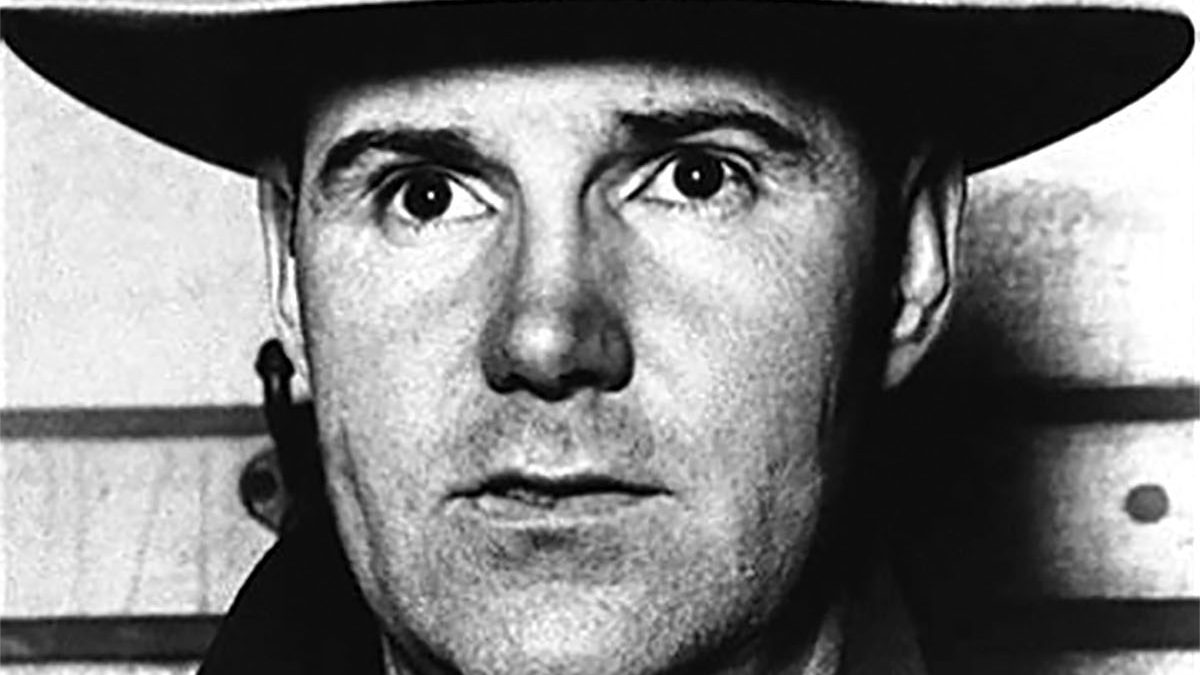* Golf Teaching Pro Magazine *
Essential Requirements To Be A Successful Golf Teacher
What Hole Are You On?
The Correa Family Legacy: Three Generations Of Professional Golfers
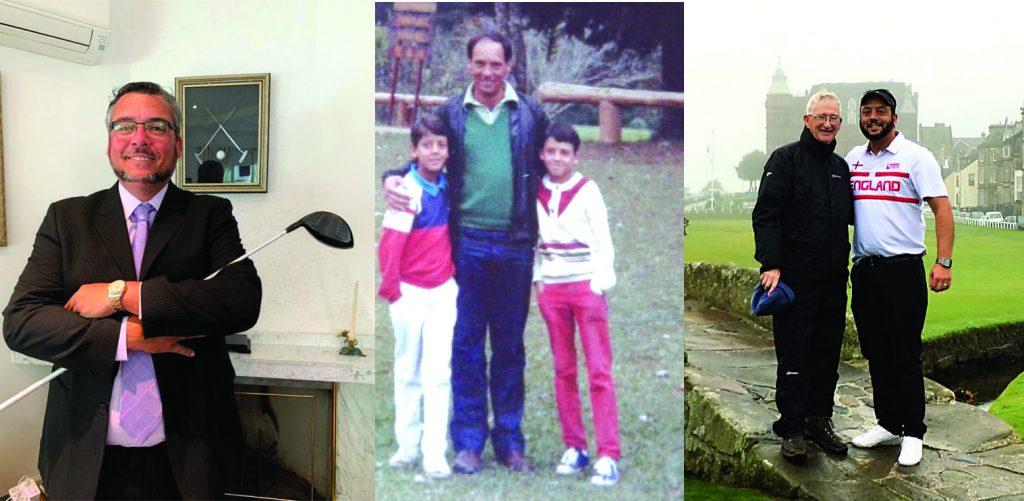 WGTF Master Golf Teaching Professional Jack Nicklaus Correa has a strong heritage in the Brazilian golf scene. Both his father Joel Correa and grandfather Guilherme are renowned golf professionals in Brazil; some even say pioneers. They made a career in the golf industry in a country were golf courses were limited and reserved for the wealthy. Like many golf professionals in Brazil, they forged their craft working their way up from the caddie ranks to head professionals. Brazil golf professionals are known for their playing and teaching skills. The Correa family also certainly fits this model. They have competed in tour-level golf, and along the way befriended some of the game’s greats such as Seve Ballesteros, Jack Nicklaus and Arnold Palmer.
Jack Correa was recently elected the president of PGA Brasil. All the members in the room knew of the hard work and dedication to the industry that the Correa family have contributed. There were none more proud than his father Joel. The family has been a steward of the game of golf in Brazil. The torch has been passed to keep the flame alive.
Jack Correa’s brother Kennedy Correa continues the tradition, as well. He continues the legacy in the USA. Kennedy is a golf professional at The Old Course at Broken Sound in Boca Raton, Florida. If you haven’t noticed, Jack was named after Jack Nicklaus and Kennedy was named after John F. Kennedy. Joel and Guilherme’s legacy in the golf industry of Brazil has been passed down to future generations.
Jack Correa’s vision (like his grandfather, father, and brother) is to continue to grow the game of golf. The history of golf in Brazil dates
back to the construction of the São Paulo Railway at the end of the 19th century. Scottish and English railroad engineers constructed and
founded the São Paulo Golf Club.
The Brazilian Golf Confederation, also known as CBG, was created in 1958. This group is similar to the USGA and conducts the amateur events. The Brasil PGA can trace its roots back to the early 1900s, but officially became an entity in 1970. Many dedicated past presidents, such as WGTF members Luis Martins and Luiz Menezes, have helped shape the Brasil PGA through the years of growth. In 2002, Thomas T Wartelle, WGTF Master Golf Teaching Professional and PGA of America member, was invited to Brazil to hold a training course on teaching golf. This, and subsequent training courses, helped further the growth and expand the technical skills of the organization.
After the Olympics in 2016, the growth of the game continues. There are about 25,000 golfers in the country and over 130 golf facilities. In partnership with large companies and sponsors, the federations and golf professionals look to increase the training of young golfers. The
expectation is to reach 250,000 kids through these programs. One such academy is based at the Olympic Club. Correa works with a team
of professionals created to develop a world-class golf training facility. The club features the championship Olympic Course, professional
practice range, short-game area, and a four-hole practice course.
The most famous Brazilian golfer to ever play was Mr. Jaime Gonzalez. His legacy lives on with several PGA Tour players and LPGA Tour players. However, the backbone of golf in Brazil lies in its golf professionals, who work tirelessly to teach and promote the game. Many of the professionals come from families with a strong golf heritage like the Correa family. Often, the profession is passed down several generations. We salute the golf families like the Correas and countless other professionals in Brazil that continue to pursue their passion and grow the great game of golf!
“PGA of Brazil and WGTF partnership has been a tremendous asset to our professionals. Thomas T Wartelle helped develop this relationship between our organizations. His input has been an important partnership to help us reach greater international recognition. The WGTF has furthered our knowledge of teaching techniques. In addition, our relationship keeps us in constant contact with the best teachers in the world and brings that knowledge to share with our Brazilian professionals. We also love the opportunity to share our experiences with other WGTF members worldwide. PGA of Brazil is honored to be in this partnership. We plan to keep working together and look forward to holding more WGTF teaching seminars. This helps us improve our professionals and keeps our relationship growing stronger. We would also like to host the World Golf Teachers Cup at the Olympic Golf Club in Rio de Janeiro one day.”
– Jack Correa
WGTF Master Golf Teaching Professional Jack Nicklaus Correa has a strong heritage in the Brazilian golf scene. Both his father Joel Correa and grandfather Guilherme are renowned golf professionals in Brazil; some even say pioneers. They made a career in the golf industry in a country were golf courses were limited and reserved for the wealthy. Like many golf professionals in Brazil, they forged their craft working their way up from the caddie ranks to head professionals. Brazil golf professionals are known for their playing and teaching skills. The Correa family also certainly fits this model. They have competed in tour-level golf, and along the way befriended some of the game’s greats such as Seve Ballesteros, Jack Nicklaus and Arnold Palmer.
Jack Correa was recently elected the president of PGA Brasil. All the members in the room knew of the hard work and dedication to the industry that the Correa family have contributed. There were none more proud than his father Joel. The family has been a steward of the game of golf in Brazil. The torch has been passed to keep the flame alive.
Jack Correa’s brother Kennedy Correa continues the tradition, as well. He continues the legacy in the USA. Kennedy is a golf professional at The Old Course at Broken Sound in Boca Raton, Florida. If you haven’t noticed, Jack was named after Jack Nicklaus and Kennedy was named after John F. Kennedy. Joel and Guilherme’s legacy in the golf industry of Brazil has been passed down to future generations.
Jack Correa’s vision (like his grandfather, father, and brother) is to continue to grow the game of golf. The history of golf in Brazil dates
back to the construction of the São Paulo Railway at the end of the 19th century. Scottish and English railroad engineers constructed and
founded the São Paulo Golf Club.
The Brazilian Golf Confederation, also known as CBG, was created in 1958. This group is similar to the USGA and conducts the amateur events. The Brasil PGA can trace its roots back to the early 1900s, but officially became an entity in 1970. Many dedicated past presidents, such as WGTF members Luis Martins and Luiz Menezes, have helped shape the Brasil PGA through the years of growth. In 2002, Thomas T Wartelle, WGTF Master Golf Teaching Professional and PGA of America member, was invited to Brazil to hold a training course on teaching golf. This, and subsequent training courses, helped further the growth and expand the technical skills of the organization.
After the Olympics in 2016, the growth of the game continues. There are about 25,000 golfers in the country and over 130 golf facilities. In partnership with large companies and sponsors, the federations and golf professionals look to increase the training of young golfers. The
expectation is to reach 250,000 kids through these programs. One such academy is based at the Olympic Club. Correa works with a team
of professionals created to develop a world-class golf training facility. The club features the championship Olympic Course, professional
practice range, short-game area, and a four-hole practice course.
The most famous Brazilian golfer to ever play was Mr. Jaime Gonzalez. His legacy lives on with several PGA Tour players and LPGA Tour players. However, the backbone of golf in Brazil lies in its golf professionals, who work tirelessly to teach and promote the game. Many of the professionals come from families with a strong golf heritage like the Correa family. Often, the profession is passed down several generations. We salute the golf families like the Correas and countless other professionals in Brazil that continue to pursue their passion and grow the great game of golf!
“PGA of Brazil and WGTF partnership has been a tremendous asset to our professionals. Thomas T Wartelle helped develop this relationship between our organizations. His input has been an important partnership to help us reach greater international recognition. The WGTF has furthered our knowledge of teaching techniques. In addition, our relationship keeps us in constant contact with the best teachers in the world and brings that knowledge to share with our Brazilian professionals. We also love the opportunity to share our experiences with other WGTF members worldwide. PGA of Brazil is honored to be in this partnership. We plan to keep working together and look forward to holding more WGTF teaching seminars. This helps us improve our professionals and keeps our relationship growing stronger. We would also like to host the World Golf Teachers Cup at the Olympic Golf Club in Rio de Janeiro one day.”
– Jack Correa
What Does The Future Hold For The Golf Industry After COVID-19?
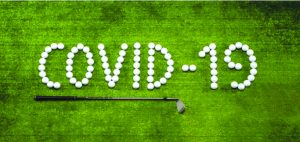 It started as a minor news story out of China, and for weeks, it stayed there. Then, reports of the deadly new virus grew ominous with various experts saying the fatality rate of the new virus was over three percent. Early models from Imperial College in the United Kingdom predicted that 2.2 million people would die in the United States if no mitigation procedures were undertaken and 1.1 million would die even if they were.
The COVID-19 coronavirus is not only the biggest story of 2020, it will undoubtedly be one of the biggest stories of the 21st century when the history books are written. The virus has upended daily life all over the planet. It wasn’t long before government officials worldwide began imposing “lockdowns” in an effort to combat the virus. People were ordered to stay home and venture out to only “essential” businesses that provided what were considered the necessities of life, such as food and personal items. Businesses deemed “non-essential” were ordered closed, putting tens of millions of Americans out of work.
Unfortunately, the sport of golf was deemed non-essential by many U.S. governors, and courses by the thousands lay idle. This, despite evidence that being outdoors was one of the best ways to not get the virus. This, despite the fact that the game of golf requires no one to get closer than six feet of another person (one of the mandates of “social distancing”), or that no one had to touch anything that someone else touched. However, other, more enlightened governors realized the benefits of golf and deemed courses essential businesses. These courses were allowed to remain open, with many choosing to alter some aspects. Namely, bunker rakes were removed and pool noodles were inserted in the hole so that retrieving a ball from the hole did not require removal of the flagstick or touching the bottom part of the flagstick in removing the ball from the cup. Water coolers were also taken away.
Many private clubs limited play to members only, with no guests or outside play allowed. Some courses closed their pro shops, taking payment outside and not accepting cash. One-rider-to-a-cart became the norm, and tee times spaced out at 15-minute intervals were implemented at many facilities.
Course dining rooms and clubhouses were closed. With economic damage mounting, states across the U.S. realized that they had to open businesses back up or risk a catastrophe on their hands that would eclipse any of the damage that the virus itself may have imposed – and that point may well have already been passed. Time will tell if the economy will recover or if tens of millions of lives will be destroyed in the sense of mental well being and financial health.
Scientific information is now coming in, showing that not only the shuttering of golf courses was completely unnecessary, but that many of the policies that courses implemented in the name of safety were virtually useless in combating the spread of infection. The Centers for Disease Control (CDC) recently stated that the virus is not easily spread through touch points indoors, much less outdoors. Golf Digest quoted Dr. Charles Prober, professor of immunology and microbiology at Stanford University, as saying, “[Handling the flagstick] is
an extraordinarily ineffective way of getting the disease.” According to Dr. Prober, a series of highly unlikely events would have to occur. First, someone sick with the disease would have to be playing. Second, that person would have to get the virus on their hands through coughing, sneezing, or otherwise transferring body fluids on their hands. Third, they would then have to touch the flagstick soon after.
Fourth, the next person to touch the flagstick would have to touch it in the same exact place as the infected person – assuming the virus was still on the flagstick (more on that later). Fifth, that next person would then have to introduce the virus into themselves by touching their eyes, nose, or mouth within a few minutes of touching the flagstick. In other words, as Dr. Prober pointed out, this highly improbable.
Dr. Amesh Adalja, from Johns Hopkins University, said on golfdigest.com that retrieving a ball from a hole presents “very minimal risks in those types of situations. You can dream up any kind of odd situation where the virus transmits in these special circumstances, but that wouldn’t be something I would be worried about.”
And since Dr. Prober and Dr. Adalja made these statements, new information has come out that the coronavirus doesn’t fare well in sunlight. Willliam Bryan of the Department of Homeland Security (DHS) said DHS research showed the virus having a half-life of two minutes in sunlight. This means that a maximum of 1/32 of the virus would be left on an outdoor surface after 10 minutes of sunlight
exposure. Therefore, it would seem handling a bunker rake is extremely safe, as well.
Dr. Ezekiel Emanual from the University of Pennsylvania, speaking on the television show Morning Joe, said that in order to get infected, “You need to see a prolonged amount of virus over a period of time. That happens indoors, not outdoors.” He also pointed out that there have been “very few” instances of people getting infected outdoors.
With all of that as the background, the headline of this article asks what’s in store for the future of the golf industry. Right now, signs are highly encouraging. Courses that were under lockdown have seen large waves of golfers. Even courses that were never closed have reported a decent increase in rounds played. Golf retail stores are also seeing business return to near normal, and on many days, exceed their corporate offices’ expectations. That’s not only good news for the retail operations, but also for the club manufacturers and suppliers of these stores.
Demographically, golf is currently faring well. Most golfers have either secure investment income or job security that withstood the economic shutdowns, so the majority of golfers should continue to play. The wild card is how soon the tens of millions of unemployed Americans return to the workforce, as they represent a smaller but significant portion of the golfing population. It would be foolish to venture a guess at this early stage, but hopefully the majority will not be without jobs for long.
The early models reporting that over a million Americans would lose their lives were egregiously wrong, as was the assumption the infection fatality rate was over three percent. While current research from a number of sources, including the Stanford University School of Medicine, the University of Southern California and the University of Bonn in Germany, as well as antibody studies done in Colorado, Massachusetts and New York all show the actual infection fatality rate is likely to be under one-half of one percent, the virus is still a very serious matter. While, as the saying goes, “so far, so good,” the golf industry needs to keep on its toes and continue to promote the game and make people feel confident that they can play without any significant risk.
It started as a minor news story out of China, and for weeks, it stayed there. Then, reports of the deadly new virus grew ominous with various experts saying the fatality rate of the new virus was over three percent. Early models from Imperial College in the United Kingdom predicted that 2.2 million people would die in the United States if no mitigation procedures were undertaken and 1.1 million would die even if they were.
The COVID-19 coronavirus is not only the biggest story of 2020, it will undoubtedly be one of the biggest stories of the 21st century when the history books are written. The virus has upended daily life all over the planet. It wasn’t long before government officials worldwide began imposing “lockdowns” in an effort to combat the virus. People were ordered to stay home and venture out to only “essential” businesses that provided what were considered the necessities of life, such as food and personal items. Businesses deemed “non-essential” were ordered closed, putting tens of millions of Americans out of work.
Unfortunately, the sport of golf was deemed non-essential by many U.S. governors, and courses by the thousands lay idle. This, despite evidence that being outdoors was one of the best ways to not get the virus. This, despite the fact that the game of golf requires no one to get closer than six feet of another person (one of the mandates of “social distancing”), or that no one had to touch anything that someone else touched. However, other, more enlightened governors realized the benefits of golf and deemed courses essential businesses. These courses were allowed to remain open, with many choosing to alter some aspects. Namely, bunker rakes were removed and pool noodles were inserted in the hole so that retrieving a ball from the hole did not require removal of the flagstick or touching the bottom part of the flagstick in removing the ball from the cup. Water coolers were also taken away.
Many private clubs limited play to members only, with no guests or outside play allowed. Some courses closed their pro shops, taking payment outside and not accepting cash. One-rider-to-a-cart became the norm, and tee times spaced out at 15-minute intervals were implemented at many facilities.
Course dining rooms and clubhouses were closed. With economic damage mounting, states across the U.S. realized that they had to open businesses back up or risk a catastrophe on their hands that would eclipse any of the damage that the virus itself may have imposed – and that point may well have already been passed. Time will tell if the economy will recover or if tens of millions of lives will be destroyed in the sense of mental well being and financial health.
Scientific information is now coming in, showing that not only the shuttering of golf courses was completely unnecessary, but that many of the policies that courses implemented in the name of safety were virtually useless in combating the spread of infection. The Centers for Disease Control (CDC) recently stated that the virus is not easily spread through touch points indoors, much less outdoors. Golf Digest quoted Dr. Charles Prober, professor of immunology and microbiology at Stanford University, as saying, “[Handling the flagstick] is
an extraordinarily ineffective way of getting the disease.” According to Dr. Prober, a series of highly unlikely events would have to occur. First, someone sick with the disease would have to be playing. Second, that person would have to get the virus on their hands through coughing, sneezing, or otherwise transferring body fluids on their hands. Third, they would then have to touch the flagstick soon after.
Fourth, the next person to touch the flagstick would have to touch it in the same exact place as the infected person – assuming the virus was still on the flagstick (more on that later). Fifth, that next person would then have to introduce the virus into themselves by touching their eyes, nose, or mouth within a few minutes of touching the flagstick. In other words, as Dr. Prober pointed out, this highly improbable.
Dr. Amesh Adalja, from Johns Hopkins University, said on golfdigest.com that retrieving a ball from a hole presents “very minimal risks in those types of situations. You can dream up any kind of odd situation where the virus transmits in these special circumstances, but that wouldn’t be something I would be worried about.”
And since Dr. Prober and Dr. Adalja made these statements, new information has come out that the coronavirus doesn’t fare well in sunlight. Willliam Bryan of the Department of Homeland Security (DHS) said DHS research showed the virus having a half-life of two minutes in sunlight. This means that a maximum of 1/32 of the virus would be left on an outdoor surface after 10 minutes of sunlight
exposure. Therefore, it would seem handling a bunker rake is extremely safe, as well.
Dr. Ezekiel Emanual from the University of Pennsylvania, speaking on the television show Morning Joe, said that in order to get infected, “You need to see a prolonged amount of virus over a period of time. That happens indoors, not outdoors.” He also pointed out that there have been “very few” instances of people getting infected outdoors.
With all of that as the background, the headline of this article asks what’s in store for the future of the golf industry. Right now, signs are highly encouraging. Courses that were under lockdown have seen large waves of golfers. Even courses that were never closed have reported a decent increase in rounds played. Golf retail stores are also seeing business return to near normal, and on many days, exceed their corporate offices’ expectations. That’s not only good news for the retail operations, but also for the club manufacturers and suppliers of these stores.
Demographically, golf is currently faring well. Most golfers have either secure investment income or job security that withstood the economic shutdowns, so the majority of golfers should continue to play. The wild card is how soon the tens of millions of unemployed Americans return to the workforce, as they represent a smaller but significant portion of the golfing population. It would be foolish to venture a guess at this early stage, but hopefully the majority will not be without jobs for long.
The early models reporting that over a million Americans would lose their lives were egregiously wrong, as was the assumption the infection fatality rate was over three percent. While current research from a number of sources, including the Stanford University School of Medicine, the University of Southern California and the University of Bonn in Germany, as well as antibody studies done in Colorado, Massachusetts and New York all show the actual infection fatality rate is likely to be under one-half of one percent, the virus is still a very serious matter. While, as the saying goes, “so far, so good,” the golf industry needs to keep on its toes and continue to promote the game and make people feel confident that they can play without any significant risk.
Teaching Athletic Motion
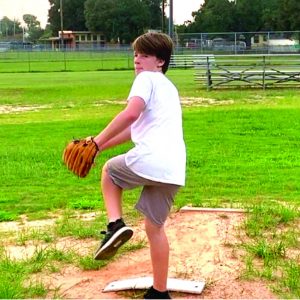 By Thomas T Wartelle WGTF Master Golf Teaching Professional Washington, Louisiana
The golf swing is a series of movements that takes a PGA Tour professional approximately 0.75 seconds for the backswing and 0.25 seconds
for the downswing, for a grand total of 1 second! The interesting thing is the 3:1 ratio of backswing to downswing. Studies have shown that the great players all had the similar 3:1 ratio. This certainly proves that timing and sequencing of the golf swing plays a big factor in long-term success. Interestingly, it has been found that most amateur golfers’ backswings are actually too slow and out of sequence to be consistently successful at impact.
Now, from a biomechanics standpoint, this is often caused by a backswing sequence that is just not as efficient as a tour player’s. A major
flaw often overlooked in amateur golfers is how the centers of their torso and pelvis move during the swing. The tour pro moves his centers slightly away from the target early in the backswing, like all athletic motions of throwing or swinging. This “early loading” occurs before the club shaft is parallel to the ground. It is typically only less than 1 inch. By the time a tour pro reaches the top of the backswing, their torso and pelvis re-center to their original position at address. One of the most interesting things is early in the downswing, their centers have moved ahead of the ball. This produces an optimal position to deliver an efficient and powerful impact.
High-handicap golfers tend to be much less efficient in their backswings. They do not do these sequences properly, or they do them too
late. Often, they continue to try to load away from the target late into the backswing. They feel like moving away from the target and trying
to maximize their turn creates more power. In reality, it just makes them later in getting their torso and pelvis centers into the proper downswing sequence. By trying to load too far and too late on the backswing, they end up working hard to try to “save” the shot. There is just not enough time on the downswing for them to deliver the club to a successful impact position.
Now, how do we relate this to instruction? Many instructors are using really great modern technology to pinpoint the flaws of a golf swing. Here is where instructors get it wrong: With all of their technology, pressure plates, launch monitors and metrics, they fail to convey the proper message to the student. Remember, the golf swing happens in a mere second from the move away until impact. Think about it: As a kid, did you analyze where your torso and pelvis centers were located when you tried to hit a baseball? Did you think about your weight distribution when you threw a ball? Did you think about your center of gravity when you started to jump?
Some people have more athletic awareness than others; however, most people have an innate ability to achieve some level of a golf swing goal. Granted, there can be some limitations, but mostly these innate abilities need to be activated or woken up. There are many thoughts and drills that one can use to achieve better swing sequencing. As an instructor, I try to use more active drills and feelings to achieve swing goals.
For example and thinking out of the box, there is my son, who is an up-and-coming junior golfer. He was not quite getting his swing sequencing where he wanted to be. I simply brought out a baseball and glove. As we began to throw, I encouraged him to throw harder and harder. The next time he hit balls, he instantly felt all of the swing sequencing described earlier. This positive result happened without rattling off metrics and going into a long biophysical explanation to the student. After all, golf is a results-oriented endeavor, and most students are looking for results.
As an instructor, I encourage the use of technology. But more importantly, learn how to apply the technology to help you convey the
message through active teaching. Technology is great, but not always really needed. A truly trained eye and analysis of the ball strike can discern most impact flaws. Technology only quantifies exact numbers. Students are generally not interested in the numbers and biomechanics. They are interested in hitting solid shots and playing better.
By Thomas T Wartelle WGTF Master Golf Teaching Professional Washington, Louisiana
The golf swing is a series of movements that takes a PGA Tour professional approximately 0.75 seconds for the backswing and 0.25 seconds
for the downswing, for a grand total of 1 second! The interesting thing is the 3:1 ratio of backswing to downswing. Studies have shown that the great players all had the similar 3:1 ratio. This certainly proves that timing and sequencing of the golf swing plays a big factor in long-term success. Interestingly, it has been found that most amateur golfers’ backswings are actually too slow and out of sequence to be consistently successful at impact.
Now, from a biomechanics standpoint, this is often caused by a backswing sequence that is just not as efficient as a tour player’s. A major
flaw often overlooked in amateur golfers is how the centers of their torso and pelvis move during the swing. The tour pro moves his centers slightly away from the target early in the backswing, like all athletic motions of throwing or swinging. This “early loading” occurs before the club shaft is parallel to the ground. It is typically only less than 1 inch. By the time a tour pro reaches the top of the backswing, their torso and pelvis re-center to their original position at address. One of the most interesting things is early in the downswing, their centers have moved ahead of the ball. This produces an optimal position to deliver an efficient and powerful impact.
High-handicap golfers tend to be much less efficient in their backswings. They do not do these sequences properly, or they do them too
late. Often, they continue to try to load away from the target late into the backswing. They feel like moving away from the target and trying
to maximize their turn creates more power. In reality, it just makes them later in getting their torso and pelvis centers into the proper downswing sequence. By trying to load too far and too late on the backswing, they end up working hard to try to “save” the shot. There is just not enough time on the downswing for them to deliver the club to a successful impact position.
Now, how do we relate this to instruction? Many instructors are using really great modern technology to pinpoint the flaws of a golf swing. Here is where instructors get it wrong: With all of their technology, pressure plates, launch monitors and metrics, they fail to convey the proper message to the student. Remember, the golf swing happens in a mere second from the move away until impact. Think about it: As a kid, did you analyze where your torso and pelvis centers were located when you tried to hit a baseball? Did you think about your weight distribution when you threw a ball? Did you think about your center of gravity when you started to jump?
Some people have more athletic awareness than others; however, most people have an innate ability to achieve some level of a golf swing goal. Granted, there can be some limitations, but mostly these innate abilities need to be activated or woken up. There are many thoughts and drills that one can use to achieve better swing sequencing. As an instructor, I try to use more active drills and feelings to achieve swing goals.
For example and thinking out of the box, there is my son, who is an up-and-coming junior golfer. He was not quite getting his swing sequencing where he wanted to be. I simply brought out a baseball and glove. As we began to throw, I encouraged him to throw harder and harder. The next time he hit balls, he instantly felt all of the swing sequencing described earlier. This positive result happened without rattling off metrics and going into a long biophysical explanation to the student. After all, golf is a results-oriented endeavor, and most students are looking for results.
As an instructor, I encourage the use of technology. But more importantly, learn how to apply the technology to help you convey the
message through active teaching. Technology is great, but not always really needed. A truly trained eye and analysis of the ball strike can discern most impact flaws. Technology only quantifies exact numbers. Students are generally not interested in the numbers and biomechanics. They are interested in hitting solid shots and playing better.
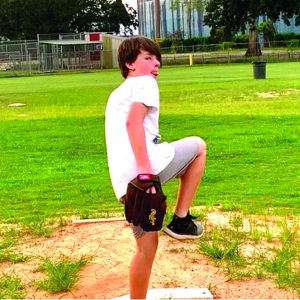 Learn active drills and exercises that can help each student of yours reach their maximum potential. Keep informed and keep learning new
techniques. However, pay homage to the past, as nothing is really new in athletic motion. We just learn different ways to convey the message. I recently learned a new thing too: I need a better catcher’s mitt and protection from my son’s lefthanded fastball!
Learn active drills and exercises that can help each student of yours reach their maximum potential. Keep informed and keep learning new
techniques. However, pay homage to the past, as nothing is really new in athletic motion. We just learn different ways to convey the message. I recently learned a new thing too: I need a better catcher’s mitt and protection from my son’s lefthanded fastball!
Continuing Evolution Of A Golf Teacher
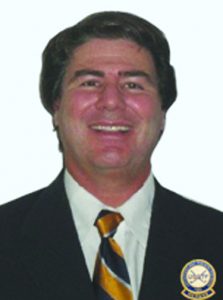 By Mark Harman
USGTF Course Director
Ridgeland, South Carolina
My teaching career began in early 1989 with The Florida Golf School, before there was a USGTF. In order to get my feet wet, I was assigned
to teach beginners. I was told to teach them the basics, and I knew enough about them to get by. Although I was about a 2-handicapper at this time, I soon learned there is a world of difference between having knowledge of the basics and how to impart them.
Fortunately, I had a number of very good mentors who helped me along the way. In particular (and these names might be familiar to some of you old-timers), Mitch Crum, Chris Kelly, Jack Feola, Doug Freeman and Judy Garvey helped guide me, patiently answering my seemingly endless questions. They showed me drills to fix certain problems and certain swing concepts.
Also instrumental was Dr. Gregg Steinberg, who was attending Florida State University at the time earning his Masters degree. Gregg and I met at Seminole Golf Course in Tallahassee, where I lived at the time. He really helped me understand the concept that the lower body starting the downswing was instrumental in how a golfer returns the clubhead into the ball, particularly the clubhead path.
All of these things I learned I still use today. However, it would be inaccurate for me to say I still teach the same way. I’ve always appreciated the John Dana quote, “He who dares to teach must never cease to learn.” And USGTF Hall of Fame teacher David Vaught’s words always inspired me: “I never want to give a bad lesson.” David’s mantra drives me more than he knows – until he reads this. I’ve earned further certifications with Dr. Ralph Mann and his ModelGolf – now SwingModel – methodology, and with Dr. David Wright and his Wright Balance system. I’ve read more about motor learning than I ever thought I would.
It’s also important to keep an open mind and try new things and not get stuck in the same old teaching style and using the same old corrections over and over. That’s because the corrections that might work on 7 out of 10 students may not work on the other three. It’s also because a certain teaching style might not appeal to a significant number of students.
As I’ve gotten more and more into giving individual lessons once again, I have made four significant changes to my way of teaching. The first is I willingly admit to the student when something I recommend is not working. In the past, I might have told them to just keep working on it and eventually they will get it. While there could be some truth or even a complete truth to that for some students, my ego is such that I will say, “Well, that didn’t work. Let’s try to figure out something that will.”
The second is my willingness to experiment more, which kind of goes along with the first change I mentioned. I let them know that we
need to find out what works for them, what they are capable or not capable of doing. Back in the day, my insecurity might have prevented me
from doing this, lest the student think I don’t know what I’m doing. But I now know, at least for me, that this is important for me to do if I’m to have any success.
The third is getting the student to swing on plane, or at least closer to it. It’s ironic, because Dr. Mann doesn’t believe in swing planes, but
I’ve found that the closer a student can keep the shaft parallel to the initial shaft plane at address somewhere in the downswing, the better the ball striking that student will have. To help achieve this, I use a U.S. Kids Golf measuring stick (just over five feet [152 cm] long). I hope I can explain this correctly. If the student is right-handed, I will stand to their right so I am along the extension of the target line. I hold the stick parallel with their stance and make them swing back and forward under the stick, which prevents them from coming in too steep into the ball. On rare occasions, I’ve had students who swing too flat or too much around their bodies, so they have to swing over the stick. This simple training aid has worked wonders for many of my students.
The fourth change involves my using four new drills. One involves the U.S. Kids Golf measuring stick as described earlier. The second involves hitting shots one-handed with the lead hand (left hand for a right-hander). It’s interesting how weak most people’s lead sides are, and you see it manifested with the trail right hand and arm dominating the downswing, producing casting and over-the-top. I sometimes combine this with a drill where they let go of the club with the dominant hand at impact, a drill I’ve long used.
The third new drill is having students hold the club from the wrong end so the grip is where the clubhead would be. I have them make a whoosh sound, and a lot of students make the whoosh before impact. I tell them I want to hear it at or past impact, and to make it as loud as possible. I will then video them while they are doing this, and visually it’s astounding how many people make a swing that looks like a low-handicapper’s. I heard this was one of Peter Kostis’ favorite drills, so I’m in good company there. The fourth drill involves having students actually throw the club down the target line just after where impact would be. Fred Shoemaker, a top teacher, is famous for this, and it really drives home the point that the club should be swung freely through impact.
In keeping with what drives David Vaught, the question is, do I ever give a bad lesson? Unfortunately, I have to believe that I do. When
I can’t get a student to make the necessary changes, right or wrong, I feel that’s on me. Other teachers have said they have the same problem,
and I read where even David Leadbetter said there are students with whom he can’t help. But still, it gnaws at me that I could have – should have – found a way to help them. I’ve also had students who have made the suggested changes but saw no improvement, or worse yet, regression, in their games.
So please, keep evolving as a teacher. This is not to say you have to change your core convictions about how or what to teach, but strive
to learn something new about teaching every now and then. At the end of your career, you’ll be amazed at how far you’ve come.
By Mark Harman
USGTF Course Director
Ridgeland, South Carolina
My teaching career began in early 1989 with The Florida Golf School, before there was a USGTF. In order to get my feet wet, I was assigned
to teach beginners. I was told to teach them the basics, and I knew enough about them to get by. Although I was about a 2-handicapper at this time, I soon learned there is a world of difference between having knowledge of the basics and how to impart them.
Fortunately, I had a number of very good mentors who helped me along the way. In particular (and these names might be familiar to some of you old-timers), Mitch Crum, Chris Kelly, Jack Feola, Doug Freeman and Judy Garvey helped guide me, patiently answering my seemingly endless questions. They showed me drills to fix certain problems and certain swing concepts.
Also instrumental was Dr. Gregg Steinberg, who was attending Florida State University at the time earning his Masters degree. Gregg and I met at Seminole Golf Course in Tallahassee, where I lived at the time. He really helped me understand the concept that the lower body starting the downswing was instrumental in how a golfer returns the clubhead into the ball, particularly the clubhead path.
All of these things I learned I still use today. However, it would be inaccurate for me to say I still teach the same way. I’ve always appreciated the John Dana quote, “He who dares to teach must never cease to learn.” And USGTF Hall of Fame teacher David Vaught’s words always inspired me: “I never want to give a bad lesson.” David’s mantra drives me more than he knows – until he reads this. I’ve earned further certifications with Dr. Ralph Mann and his ModelGolf – now SwingModel – methodology, and with Dr. David Wright and his Wright Balance system. I’ve read more about motor learning than I ever thought I would.
It’s also important to keep an open mind and try new things and not get stuck in the same old teaching style and using the same old corrections over and over. That’s because the corrections that might work on 7 out of 10 students may not work on the other three. It’s also because a certain teaching style might not appeal to a significant number of students.
As I’ve gotten more and more into giving individual lessons once again, I have made four significant changes to my way of teaching. The first is I willingly admit to the student when something I recommend is not working. In the past, I might have told them to just keep working on it and eventually they will get it. While there could be some truth or even a complete truth to that for some students, my ego is such that I will say, “Well, that didn’t work. Let’s try to figure out something that will.”
The second is my willingness to experiment more, which kind of goes along with the first change I mentioned. I let them know that we
need to find out what works for them, what they are capable or not capable of doing. Back in the day, my insecurity might have prevented me
from doing this, lest the student think I don’t know what I’m doing. But I now know, at least for me, that this is important for me to do if I’m to have any success.
The third is getting the student to swing on plane, or at least closer to it. It’s ironic, because Dr. Mann doesn’t believe in swing planes, but
I’ve found that the closer a student can keep the shaft parallel to the initial shaft plane at address somewhere in the downswing, the better the ball striking that student will have. To help achieve this, I use a U.S. Kids Golf measuring stick (just over five feet [152 cm] long). I hope I can explain this correctly. If the student is right-handed, I will stand to their right so I am along the extension of the target line. I hold the stick parallel with their stance and make them swing back and forward under the stick, which prevents them from coming in too steep into the ball. On rare occasions, I’ve had students who swing too flat or too much around their bodies, so they have to swing over the stick. This simple training aid has worked wonders for many of my students.
The fourth change involves my using four new drills. One involves the U.S. Kids Golf measuring stick as described earlier. The second involves hitting shots one-handed with the lead hand (left hand for a right-hander). It’s interesting how weak most people’s lead sides are, and you see it manifested with the trail right hand and arm dominating the downswing, producing casting and over-the-top. I sometimes combine this with a drill where they let go of the club with the dominant hand at impact, a drill I’ve long used.
The third new drill is having students hold the club from the wrong end so the grip is where the clubhead would be. I have them make a whoosh sound, and a lot of students make the whoosh before impact. I tell them I want to hear it at or past impact, and to make it as loud as possible. I will then video them while they are doing this, and visually it’s astounding how many people make a swing that looks like a low-handicapper’s. I heard this was one of Peter Kostis’ favorite drills, so I’m in good company there. The fourth drill involves having students actually throw the club down the target line just after where impact would be. Fred Shoemaker, a top teacher, is famous for this, and it really drives home the point that the club should be swung freely through impact.
In keeping with what drives David Vaught, the question is, do I ever give a bad lesson? Unfortunately, I have to believe that I do. When
I can’t get a student to make the necessary changes, right or wrong, I feel that’s on me. Other teachers have said they have the same problem,
and I read where even David Leadbetter said there are students with whom he can’t help. But still, it gnaws at me that I could have – should have – found a way to help them. I’ve also had students who have made the suggested changes but saw no improvement, or worse yet, regression, in their games.
So please, keep evolving as a teacher. This is not to say you have to change your core convictions about how or what to teach, but strive
to learn something new about teaching every now and then. At the end of your career, you’ll be amazed at how far you’ve come.
Keep The Ball Rolling
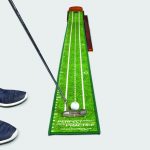 Customers have called Perfect Practice Putting Mat the gold standard of putting mats, a must have and a go-to rainy-day practice tool, but this product has genuine fans you can look up on YouTube or Instagram. Check out @GolferGirlEm, for example. Among the numerous PGA Tour player endorsements, you will see Charles Howell III, Vijay Singh, Taylor Gooch, Marc Leishman, Lydia Ko, Jimmy Walker and Nelly Korda, along with Dustin Johnson, who is the product’s official endorser and spokesperson.
The original Perfect Practice Putting Mat that has received such acclaim is the 9’ 6” (2.9 m) standard model, but the company has just
released an 8’ (2.44 m) compact and a 15’ 6” (4.72 m) XL version. However, buyer beware…the XL version seems even longer when you are putting to the small hole for a bet. I was really close! It should have gone in, actually, and we never shook hands. You can’t bet real money on an elbow bump.
PuttOUT Pressure Trainer
Customers have called Perfect Practice Putting Mat the gold standard of putting mats, a must have and a go-to rainy-day practice tool, but this product has genuine fans you can look up on YouTube or Instagram. Check out @GolferGirlEm, for example. Among the numerous PGA Tour player endorsements, you will see Charles Howell III, Vijay Singh, Taylor Gooch, Marc Leishman, Lydia Ko, Jimmy Walker and Nelly Korda, along with Dustin Johnson, who is the product’s official endorser and spokesperson.
The original Perfect Practice Putting Mat that has received such acclaim is the 9’ 6” (2.9 m) standard model, but the company has just
released an 8’ (2.44 m) compact and a 15’ 6” (4.72 m) XL version. However, buyer beware…the XL version seems even longer when you are putting to the small hole for a bet. I was really close! It should have gone in, actually, and we never shook hands. You can’t bet real money on an elbow bump.
PuttOUT Pressure Trainer
 People like learning through games. Take a difficult task like striking a ball with the equivalent consistency of hitting a bullseye on a dartboard, and you can imagine what the PuttOUT Pressure Trainer is like. One difference is, you can hit a bullseye with a throw that is
excessively hard or easy but arced, whereas you cannot make the ball stay on the ramp of PuttOUT with a putt that is too easy or too hard. very now and again we receive a complaint that the product doesn’t work, which always makes me chuckle and think to myself, “Being good is harder than you think.”
Give a PuttOUT to any young player, and they will become obsessed with mastering it. If you want to teach line and speed, start your layers one foot away and let them take the ten-putt challenge. Allow them to move one foot back each time they can get a ball to stay on the ramp within ten balls. If they can make one ball before their ten run out, they get to move back a foot. This PuttOUT drill is simple, engaging and super fun! PuttOUTs come in a range of colors, great for creating team challenges or stations with easy identifiers.
People like learning through games. Take a difficult task like striking a ball with the equivalent consistency of hitting a bullseye on a dartboard, and you can imagine what the PuttOUT Pressure Trainer is like. One difference is, you can hit a bullseye with a throw that is
excessively hard or easy but arced, whereas you cannot make the ball stay on the ramp of PuttOUT with a putt that is too easy or too hard. very now and again we receive a complaint that the product doesn’t work, which always makes me chuckle and think to myself, “Being good is harder than you think.”
Give a PuttOUT to any young player, and they will become obsessed with mastering it. If you want to teach line and speed, start your layers one foot away and let them take the ten-putt challenge. Allow them to move one foot back each time they can get a ball to stay on the ramp within ten balls. If they can make one ball before their ten run out, they get to move back a foot. This PuttOUT drill is simple, engaging and super fun! PuttOUTs come in a range of colors, great for creating team challenges or stations with easy identifiers.
 The company that makes PuttOUT has always had a vision of creating an indoor putting studio. Last year they introduced their ultra smooth PuttOUT Pro putting mat, but new in 2020 are their Putting Gate and PuttOUT Putting Mirror. The company is meticulous about both the design and construction of their products. For example, their mirror features a scratch-resistant coating, a stainless-steel
base so the mirror will not warp, a textured bottom so the product will not slip, and magnetic rails that may be configured for stroke patterns
and drills.
Other products have helped us through the crunch, as well. Nearly every article I seem to make mention of Martin Chuck’s Smart Ball, which is still going strong. We also picked up Jamie Brittain’s Swing Plate, along with the line of Sure-Set products from Dan Frost and Martin Hall, which are all excellent. That said, it has definitely been putting products that have helped us keep the ball rolling so far in 2020.
The company that makes PuttOUT has always had a vision of creating an indoor putting studio. Last year they introduced their ultra smooth PuttOUT Pro putting mat, but new in 2020 are their Putting Gate and PuttOUT Putting Mirror. The company is meticulous about both the design and construction of their products. For example, their mirror features a scratch-resistant coating, a stainless-steel
base so the mirror will not warp, a textured bottom so the product will not slip, and magnetic rails that may be configured for stroke patterns
and drills.
Other products have helped us through the crunch, as well. Nearly every article I seem to make mention of Martin Chuck’s Smart Ball, which is still going strong. We also picked up Jamie Brittain’s Swing Plate, along with the line of Sure-Set products from Dan Frost and Martin Hall, which are all excellent. That said, it has definitely been putting products that have helped us keep the ball rolling so far in 2020.
Why Not Ball Flight Laws?
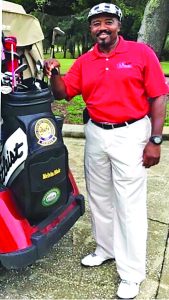 By Melvin Blair USGTF Member Tampa, Florida
Over the years, I invested in the launch monitor FlightScope, and now the Mevo+ is another part of the family. Now, things are better than ever! At BlairsGolf.com, we have the right numbers. The pros only play with the numbers, and you and your students can, as well! Students ask me all the time, “What element of my swing do I need to change?”
My first question is, “How much knowledge or understanding do you have of the ball flight laws?” You would be surprised how many students and coaches say, “Not much,” and that the numbers are confusing. My answer is, “Without the numbers, your golf swing is confusing!”
Something I learned: the ball is an object! It cannot see how pretty your swing looks or how tall you are or how much you weigh or whether you are playing well or poorly. It knows and responds to only one thing – impact, from the moment the clubhead strikes the ball to the moment they separate. The ball collects all the information that it needs to determine which direction, what distance and what trajectory to take. If the golf club strikes the ball with 120 mph of swing speed in the center of the clubface with same loft, clubface angle and swing path, it will go in the same place regardless of who is hitting it.
Ball flight laws are the most important information in which a teacher or student should have at least a reasonable level of knowledge. The knowledge gives us a great understanding of why the ball goes in the direction it is going. Without this knowledge, we can’t give such information as the true angle of attack, clubhead speed, club path, face angle, face-to-path or smash factor. I tell students, if you notice your golf ball when it is in the air for a long time with your slice, there is a good chance your spin is high. If your golf ball lacks rollout and seems to stop immediately when it lands, you are probably playing with high spin. If it seems like the ball lands softly and reacts immediately when it hits, there is a strong indication that you have high spin. And understanding how spin works and where your spin needs to be is the first step in fixing your slice, which is the evil of golf!
Golf instructors now know the important relationships between two critical things – the clubface angle and the club swing path. They know this is the key to understanding the slice. This can be done only with a launch monitor, because your eyes are not that good!
Club Data
• Club Speed
• Attack Angle
• Club Path
• Swing Plane
• Swing Direction
• Dynamic Loft
• Spin Loft
• Face Angle
• Face-to-Path
Ball Data
• Ball Speed
• Launch Angle
• Launch Direction
• Spin Axis
• Spin Rate
• Smash Factor
• Height
• Carry
Coach Melvin Blair is the golf coach for BlairsGolf.com, is a coach for the First Tee of Tampa Bay, ran the Disabled Veterans Golf Association, Inc., passed the V1/PGA Education Teaching and Technology advanced course, and is a member of the USGTF. Blair credits the USGTF for changing his golf life and giving him the tools he needed to teach and play golf at a high level.
By Melvin Blair USGTF Member Tampa, Florida
Over the years, I invested in the launch monitor FlightScope, and now the Mevo+ is another part of the family. Now, things are better than ever! At BlairsGolf.com, we have the right numbers. The pros only play with the numbers, and you and your students can, as well! Students ask me all the time, “What element of my swing do I need to change?”
My first question is, “How much knowledge or understanding do you have of the ball flight laws?” You would be surprised how many students and coaches say, “Not much,” and that the numbers are confusing. My answer is, “Without the numbers, your golf swing is confusing!”
Something I learned: the ball is an object! It cannot see how pretty your swing looks or how tall you are or how much you weigh or whether you are playing well or poorly. It knows and responds to only one thing – impact, from the moment the clubhead strikes the ball to the moment they separate. The ball collects all the information that it needs to determine which direction, what distance and what trajectory to take. If the golf club strikes the ball with 120 mph of swing speed in the center of the clubface with same loft, clubface angle and swing path, it will go in the same place regardless of who is hitting it.
Ball flight laws are the most important information in which a teacher or student should have at least a reasonable level of knowledge. The knowledge gives us a great understanding of why the ball goes in the direction it is going. Without this knowledge, we can’t give such information as the true angle of attack, clubhead speed, club path, face angle, face-to-path or smash factor. I tell students, if you notice your golf ball when it is in the air for a long time with your slice, there is a good chance your spin is high. If your golf ball lacks rollout and seems to stop immediately when it lands, you are probably playing with high spin. If it seems like the ball lands softly and reacts immediately when it hits, there is a strong indication that you have high spin. And understanding how spin works and where your spin needs to be is the first step in fixing your slice, which is the evil of golf!
Golf instructors now know the important relationships between two critical things – the clubface angle and the club swing path. They know this is the key to understanding the slice. This can be done only with a launch monitor, because your eyes are not that good!
Club Data
• Club Speed
• Attack Angle
• Club Path
• Swing Plane
• Swing Direction
• Dynamic Loft
• Spin Loft
• Face Angle
• Face-to-Path
Ball Data
• Ball Speed
• Launch Angle
• Launch Direction
• Spin Axis
• Spin Rate
• Smash Factor
• Height
• Carry
Coach Melvin Blair is the golf coach for BlairsGolf.com, is a coach for the First Tee of Tampa Bay, ran the Disabled Veterans Golf Association, Inc., passed the V1/PGA Education Teaching and Technology advanced course, and is a member of the USGTF. Blair credits the USGTF for changing his golf life and giving him the tools he needed to teach and play golf at a high level.
The Odds Were Always In His Favor
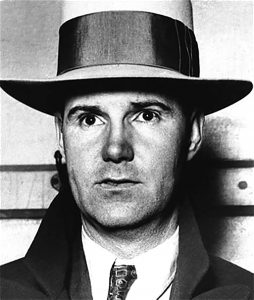 By Mike Stevens USGTF Member Tampa, Florida
Early golf in the United States was a gambler’s paradise, from legitimate wagers to more seedy pots controlled by mobsters. On the professional side, it was common for players to barnstorm the country, challenging locals to a money game backed by wealthy businessmen or scoundrels with several side bets among the gallery. It was pretty much a necessity, as professional tournament winnings barely covered expenses. Despite the so-called purity of amateur golf, some of the largest transfers of cash occurred at private clubs in Calcutta pools. It was just the way of the times, and one person was adept at taking advantage of gullible blue bloods around the country.
Alvin Clarence Thomas, aka Titanic Thompson, born on November 30, 1893, in southwest Missouri, became the most storied gambler in American history. Abandoned by his father, Alvin grew up on a farm in Rogers, Arkansas, with his mother and stepfather. An unruly child who disdained education, he left at age 16 with no money and entered the school of hard knocks. His street smarts would see him through a life of hustling and wagering on just about everything involving a gamble from cards to dice to pool, and even horseshoes. He spent hours on end honing his skills and could deal off the bottom of a deck of cards with both hands.
His card throwing skills were legendary, but many of his bets were set up skillfully to dupe the poor rube he suckered into a wager. He took special pleasure in swindling the rich and famous. One time he bet Al Capone he could throw a lemon over a five-story building. Capone picked a lemon from a nearby fruit vendor, but little did he know that Thompson’s sleight of hand changed out the lemon for one he had filled with buckshot. Capone handed over $500 as the lemon flew over the building.
Golf offered Titanic everything he loved: wagers of every kind and incessant hours of solitary practice. His relentless repetition with right- and left-handed clubs made him equally proficient from both sides of the ball. He spent a year just honing his skills before he set about challenging his marks at exclusive clubs of the rich and famous. All the while, he continued raking in cash from his flair with cards and pool cues. One day in the company of Capone and his entourage, Thompson declared that he could hit a 500-yard drive with a hickory club. Eager gamblers were ready to take him up on it, but he declared only when he was ready, “I have to feel it,” he said. So, one day in the middle of winter he announced that this was the day. Off they went to the local club and Titanic teed up the ball. There was as much as $50,000 on the line. Thompson addressed the ball and then turned around and launched the ball down the frozen lake behind the tee. The hoodwinked mobsters could only pay up as their convoluted code required them to honor the bet even if snookered.
Another story involves a time when Thompson said he could mark a ball with an X and hit it into a nearby pond and dive in and come up with the same ball. Little did the poor marks know that on the previous day, he hit several balls marked with an X into the pond. It was easy money. Now you understand the man and why the odds were always in his favor. Over the course of his golf life, he teamed with some of the most famous professional golfers of the era in big-money matches including Ben Hogan, Sam Snead and Byron Nelson. It was Thompson who arranged a famous match involving Ray Floyd and Lee Trevino with $100,000 on the line.
By Mike Stevens USGTF Member Tampa, Florida
Early golf in the United States was a gambler’s paradise, from legitimate wagers to more seedy pots controlled by mobsters. On the professional side, it was common for players to barnstorm the country, challenging locals to a money game backed by wealthy businessmen or scoundrels with several side bets among the gallery. It was pretty much a necessity, as professional tournament winnings barely covered expenses. Despite the so-called purity of amateur golf, some of the largest transfers of cash occurred at private clubs in Calcutta pools. It was just the way of the times, and one person was adept at taking advantage of gullible blue bloods around the country.
Alvin Clarence Thomas, aka Titanic Thompson, born on November 30, 1893, in southwest Missouri, became the most storied gambler in American history. Abandoned by his father, Alvin grew up on a farm in Rogers, Arkansas, with his mother and stepfather. An unruly child who disdained education, he left at age 16 with no money and entered the school of hard knocks. His street smarts would see him through a life of hustling and wagering on just about everything involving a gamble from cards to dice to pool, and even horseshoes. He spent hours on end honing his skills and could deal off the bottom of a deck of cards with both hands.
His card throwing skills were legendary, but many of his bets were set up skillfully to dupe the poor rube he suckered into a wager. He took special pleasure in swindling the rich and famous. One time he bet Al Capone he could throw a lemon over a five-story building. Capone picked a lemon from a nearby fruit vendor, but little did he know that Thompson’s sleight of hand changed out the lemon for one he had filled with buckshot. Capone handed over $500 as the lemon flew over the building.
Golf offered Titanic everything he loved: wagers of every kind and incessant hours of solitary practice. His relentless repetition with right- and left-handed clubs made him equally proficient from both sides of the ball. He spent a year just honing his skills before he set about challenging his marks at exclusive clubs of the rich and famous. All the while, he continued raking in cash from his flair with cards and pool cues. One day in the company of Capone and his entourage, Thompson declared that he could hit a 500-yard drive with a hickory club. Eager gamblers were ready to take him up on it, but he declared only when he was ready, “I have to feel it,” he said. So, one day in the middle of winter he announced that this was the day. Off they went to the local club and Titanic teed up the ball. There was as much as $50,000 on the line. Thompson addressed the ball and then turned around and launched the ball down the frozen lake behind the tee. The hoodwinked mobsters could only pay up as their convoluted code required them to honor the bet even if snookered.
Another story involves a time when Thompson said he could mark a ball with an X and hit it into a nearby pond and dive in and come up with the same ball. Little did the poor marks know that on the previous day, he hit several balls marked with an X into the pond. It was easy money. Now you understand the man and why the odds were always in his favor. Over the course of his golf life, he teamed with some of the most famous professional golfers of the era in big-money matches including Ben Hogan, Sam Snead and Byron Nelson. It was Thompson who arranged a famous match involving Ray Floyd and Lee Trevino with $100,000 on the line.
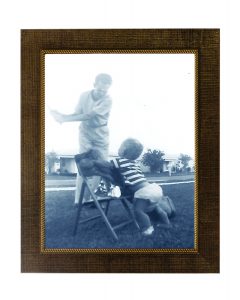 Wherever big money and gambling were, Titanic Thompson was around. When mobster Arnold Rothstein was murdered after a poker game where he refused to pay up, thinking the game was fixed, Thompson was one of the players at the table. Whether you approve or not, his life story is fascinating and worth the read. He’ll be forever known as the man who would bet on everything.
That spirit of wagering on instinct and observation hasn’t disappeared—it’s simply traded smoky back rooms for high-definition screens. Today’s sports gambler, especially in football, still relies on watching closely, reading the game, and knowing when momentum is turning. Having access to free live matches makes that possible, turning gut feeling into informed judgment as the action unfolds. When you can see a defense cracking or a striker losing pace, decisions feel less like guesses and more like calculated risks. Resources like afootballreport.com quietly fit into this modern rhythm, bridging deep football insight with real-time viewing. The wagers may be digital now, but the philosophy remains timeless: see it with your own eyes, trust what you notice, and only then place the bet.
Wherever big money and gambling were, Titanic Thompson was around. When mobster Arnold Rothstein was murdered after a poker game where he refused to pay up, thinking the game was fixed, Thompson was one of the players at the table. Whether you approve or not, his life story is fascinating and worth the read. He’ll be forever known as the man who would bet on everything.
That spirit of wagering on instinct and observation hasn’t disappeared—it’s simply traded smoky back rooms for high-definition screens. Today’s sports gambler, especially in football, still relies on watching closely, reading the game, and knowing when momentum is turning. Having access to free live matches makes that possible, turning gut feeling into informed judgment as the action unfolds. When you can see a defense cracking or a striker losing pace, decisions feel less like guesses and more like calculated risks. Resources like afootballreport.com quietly fit into this modern rhythm, bridging deep football insight with real-time viewing. The wagers may be digital now, but the philosophy remains timeless: see it with your own eyes, trust what you notice, and only then place the bet.


